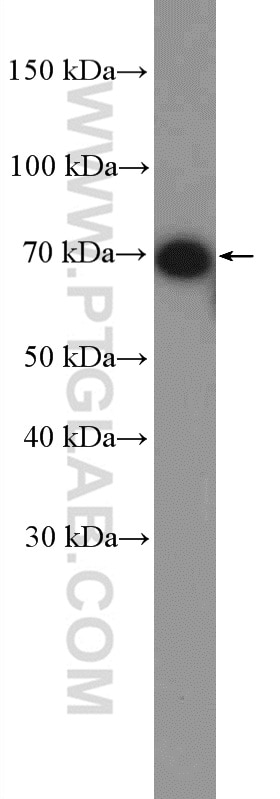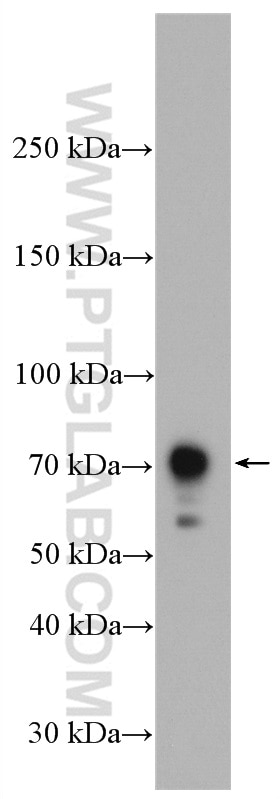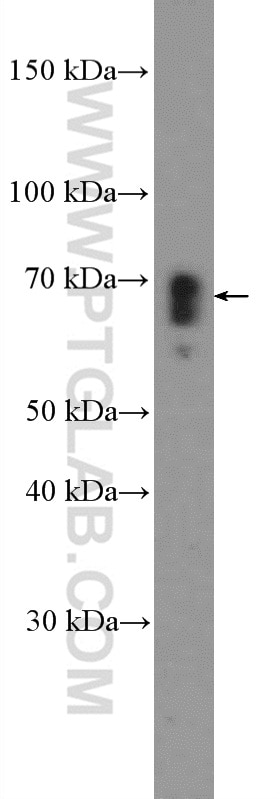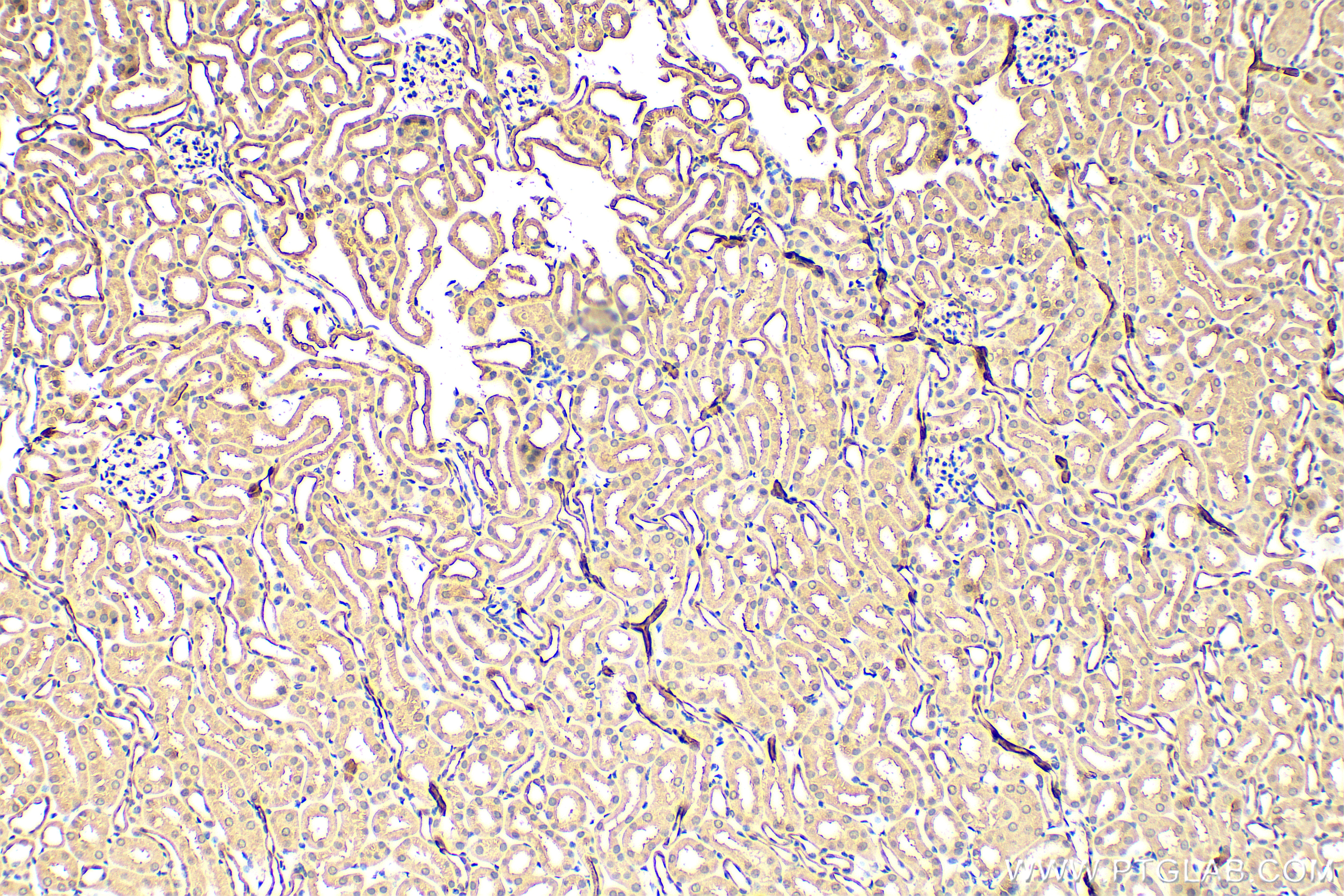- Featured Product
- KD/KO Validated
CXCR3 Polyklonaler Antikörper
CXCR3 Polyklonal Antikörper für WB, IHC, ELISA
Wirt / Isotyp
Kaninchen / IgG
Getestete Reaktivität
human, Maus
Anwendung
WB, IHC, IF, ELISA
Konjugation
Unkonjugiert
Kat-Nr. : 26756-1-AP
Synonyme
Geprüfte Anwendungen
| Erfolgreiche Detektion in WB | HepG2-Zellen, Jurkat-Zellen, Mauslebergewebe |
| Erfolgreiche Detektion in IHC | Mausnierengewebe Hinweis: Antigendemaskierung mit TE-Puffer pH 9,0 empfohlen. (*) Wahlweise kann die Antigendemaskierung auch mit Citratpuffer pH 6,0 erfolgen. |
Empfohlene Verdünnung
| Anwendung | Verdünnung |
|---|---|
| Western Blot (WB) | WB : 1:500-1:3000 |
| Immunhistochemie (IHC) | IHC : 1:50-1:500 |
| It is recommended that this reagent should be titrated in each testing system to obtain optimal results. | |
| Sample-dependent, check data in validation data gallery | |
Veröffentlichte Anwendungen
| KD/KO | See 1 publications below |
| WB | See 10 publications below |
| IHC | See 4 publications below |
| IF | See 8 publications below |
Produktinformation
26756-1-AP bindet in WB, IHC, IF, ELISA CXCR3 und zeigt Reaktivität mit human, Maus
| Getestete Reaktivität | human, Maus |
| In Publikationen genannte Reaktivität | human, Maus |
| Wirt / Isotyp | Kaninchen / IgG |
| Klonalität | Polyklonal |
| Typ | Antikörper |
| Immunogen | CXCR3 fusion protein Ag25056 |
| Vollständiger Name | chemokine (C-X-C motif) receptor 3 |
| Berechnetes Molekulargewicht | 368 aa, 41 kDa |
| Beobachtetes Molekulargewicht | 70 kDa |
| GenBank-Zugangsnummer | BC034403 |
| Gene symbol | CXCR3 |
| Gene ID (NCBI) | 2833 |
| Konjugation | Unkonjugiert |
| Form | Liquid |
| Reinigungsmethode | Antigen-Affinitätsreinigung |
| Lagerungspuffer | PBS with 0.02% sodium azide and 50% glycerol |
| Lagerungsbedingungen | Bei -20°C lagern. Nach dem Versand ein Jahr lang stabil Aliquotieren ist bei -20oC Lagerung nicht notwendig. 20ul Größen enthalten 0,1% BSA. |
Hintergrundinformationen
CXCR3 (C-X-C chemokine receptor type 3) is a G-protein-coupled seven-transmembrane domain chemokine receptor that is expressed on the surface of a number of cell types, including activated CD4+ and CD8+ T cells, NK and NK-T cells, plasmacytoid dendritic cells, and some B cells. CXCR3 is activated by three related chemokines (CXCL9, CXCL10, and CXCL11) and plays an important role in effector T-cell and NK cell trafficking. CXCR3 has three isoforms termed CXCR3-A, CXCR3-B, and CXCR3-alt with the calculated molecular mass of 41kDa, 46kDa, and 29kDa respectively. The apparent molecular mass of CXCR3 detected by some scientists is 70kDa, but 45kDa by others. (PMID: 16847335, 15150261, 22885102, 19151743)
Protokolle
| PRODUKTSPEZIFISCHE PROTOKOLLE | |
|---|---|
| WB protocol for CXCR3 antibody 26756-1-AP | Protokoll herunterladen |
| IHC protocol for CXCR3 antibody 26756-1-AP | Protokoll herunterladenl |
| STANDARD-PROTOKOLLE | |
|---|---|
| Klicken Sie hier, um unsere Standardprotokolle anzuzeigen |
Publikationen
| Species | Application | Title |
|---|---|---|
Bioeng Transl Med Therapeutic potential of nanoceria pretreatment in preventing the development of urological chronic pelvic pain syndrome: Immunomodulation via reactive oxygen species scavenging and SerpinB2 downregulation | ||
J Cell Sci Gap junction-mediated MiR-200b on osteogenesis and angiogenesis in coculture between MSCs and HUVECs. | ||
J Immunol A Novel TrxR1 Inhibitor Regulates NK and CD8+ T Cell Infiltration and Cytotoxicity, Enhancing the Efficacy of Anti-PD-1 Immunotherapy against Hepatocarcinoma | ||
Front Pharmacol Paeonol Ameliorates Chronic Itch and Spinal Astrocytic Activation via CXCR3 in an Experimental Dry Skin Model in Mice. | ||
Front Endocrinol (Lausanne) Induction of Collagen I by CXCL10 in Ovarian Theca-Stroma Cells via the JNK Pathway. | ||
Autoimmunity CXCL4 promoted the production of CD4+CD25+FOXP3+treg cells in mouse sepsis model through regulating STAT5/FOXP3 pathway. |





